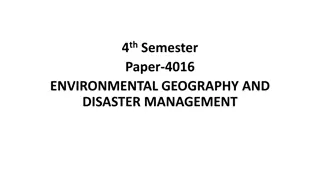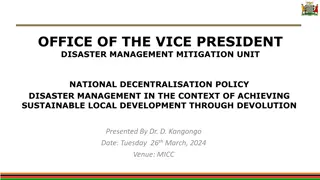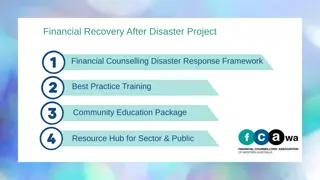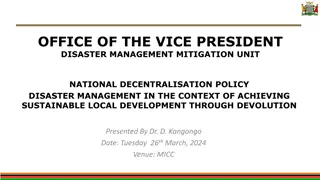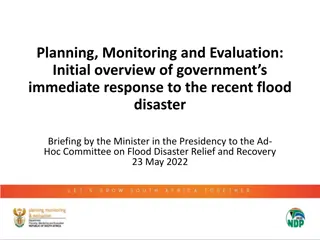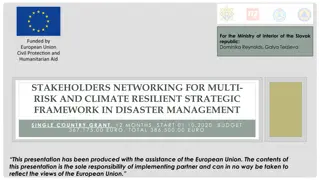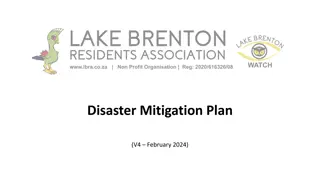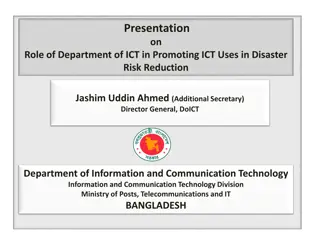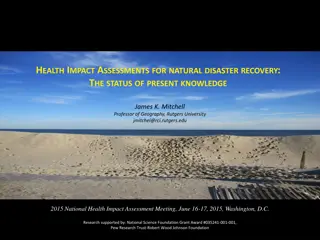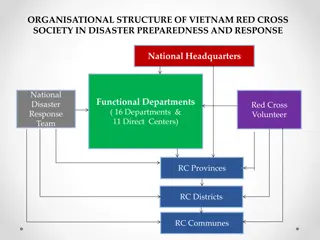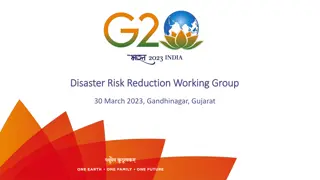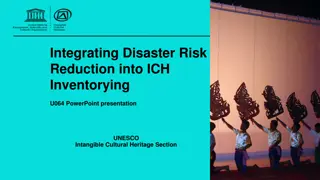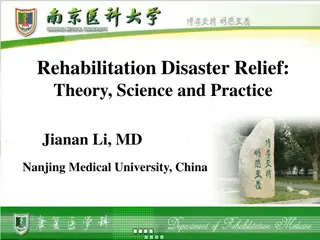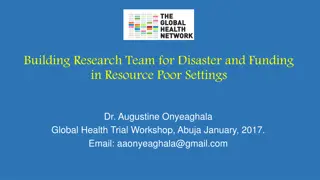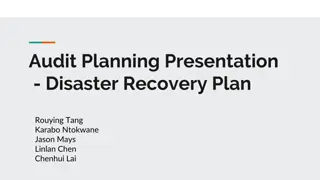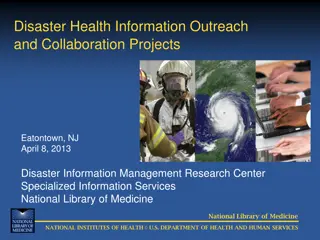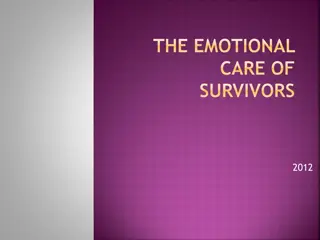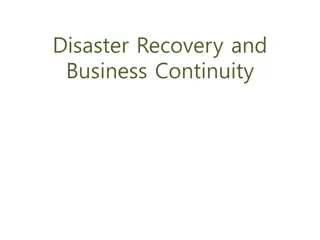
Management of Natural and Man-Made Disasters: Understanding Types and Preparedness
Explore the definition, types, and measures for disaster management, encompassing natural disasters like geophysical, hydrological, climatological, meteorological, and biological events, as well as man-made disasters such as environmental degradation, pollution, and accidents. Delve into the importance of disaster preparedness, prevention, response, recovery, and learnings for effective mitigation and community resilience.
Download Presentation

Please find below an Image/Link to download the presentation.
The content on the website is provided AS IS for your information and personal use only. It may not be sold, licensed, or shared on other websites without obtaining consent from the author. If you encounter any issues during the download, it is possible that the publisher has removed the file from their server.
You are allowed to download the files provided on this website for personal or commercial use, subject to the condition that they are used lawfully. All files are the property of their respective owners.
The content on the website is provided AS IS for your information and personal use only. It may not be sold, licensed, or shared on other websites without obtaining consent from the author.
E N D
Presentation Transcript
StudyMafia.Org Disaster Management Submitted To: Submitted By: Studymafia.org Studymafia.org
Table Contents Definition Introduction Types of Disaster Prevention of Disaster Preparation of Disaster Management Recovery of Disaster Conclusion 2
Definition Disaster management is how we deal with the human, material, economic or environmental impacts of said disaster, it is the process of how we prepare for, respond to and learn from the effects of major failures . 3
Introduction Natural disasters and armed conflict have marked human existence throughout history and have always caused peaks in mortality and morbidity. The combination of hazards, vulnerability and inability to reduce the potential negative consequences of risk results in disaster 4
Types of Disaster Natural Disasters are naturally occurring physical phenomena caused either by rapid or slow onset events that have immediate impacts on human health and secondary impacts causing further death and suffering. 6
Types of Disaster These disasters can be : Geophysical (e.g. Earthquakes, Landslides, Tsunamis and Volcanic Activity) Hydrological (e.g. Avalanches and Floods) Climatological (e.g. Extreme Temperatures, Drought and Wildfires) Meteorological (e.g. Cyclones and Storms/Wave Surges) Biological (e.g. Disease Epidemics and Insect/Animal Plagues) 7
Types of Disaster Man-Made Disasters as viewed by the International Federation of Red Cross & Red Crescent Societies are events that are caused by humans which occur in or close to human settlements often caused as a results of Environmental or Technological Emergencies. 8
Types of Disaster This can include: Environmental Degradation Pollution Accidents (e.g. Industrial, Technological and Transport usually involving the production, use or transport of hazardous materials) 9
Types of Disaster Some disasters can result from multiple hazards, or, more often, to a complex combination of both natural and man-made causes which involve a break-down of authority, looting and attacks on strategic installations, including conflict situations and war. 10
Types of Disaster These can include : Food Insecurity Epidemics Armed Conflicts Displaced Populations Extensive Violence Displacements of Populations Loss of Life Widespread Damage to both Societies and Economies 11
Types of Disaster Pandemic (from Greek pan "all" and demos "people") is an epidemic of infectious disease that has spread across a large region, which can occur to the human population or animal population and may affect health and disrupt services leading to economic and social costs. 12
Types of Disaster These have included the following epidemics: Ebola Zika Avian Flu Cholera Dengue Fever Malaria Yellow Fever Coronavirus Disease (COVID-19) 13
Prevention of Disaster UNISDR views Disaster Prevention as the concept of engaging in activities which intend to prevent or avoid potential adverse impacts through action taken in advance, activities designed to provide protection from the occurrence of disasters 15
Prevention of Disaster WCPT similarly highlight that while not all disasters can be prevented, good risk management, evacuation plans, environmental planning and design standards can reduce risk of loss of life and injury mitigation. 16
Prevention of Disaster The HYOGO Framework was one such Global Plan for natural Disaster Risk Reduction, which was adopted in 2005 as a 10 year Global Plan, signed by agreement with 168 Governments which offered guiding principles, priorities for action and practical means for achieving disaster resilience for vulnerable communities 17
Preparation of Disaster Management Disaster Preparedness refers to measures taken to prepare for and reduce the effects of disasters, be they natural or man-made. This is achieved through research and planning in order to try to predict areas or regions that may be at risk of disaster and where possible prevent these from occurring and/or reduce the impact those disasters. 18
Preparation of Disaster Management Disaster preparedness activities embedded with risk reduction measures can prevent disaster situations and also result in saving maximum lives and livelihoods during any disaster situation, enabling the affected population to get back to normalcy within a short time period 19
Preparation of Disaster Management Minimisation of loss of life and damage to property through facilitation of effective disaster response and rehabilitation services when required. Preparedness is the main way of reducing the impact of disasters. Community-based preparedness and management should be a high priority in physical therapy practice management 20
Recovery of Disaster Rescue Relocation Provision Food and Water Provision Emergency Health Care Prevention of Disease and Disability Repairing Vital Services e.g. Telecommunications, Transport Provision Temporary Shelter 21
Recovery of Disaster Rebuilding Infrastructure e.g. Homes, Schools, Hospitals, Roads Health Care and Rehabilitation Development Activities e.g. building human resources for health Development Policies and Practices to avoid or mitigate similar situations in future 22
Conclusion Disaster management is how we deal with the human, material, economic or environmental impacts of said disaster, it is the process of how we prepare for, respond to and learn from the effects of major failures . Though often caused by nature, disasters can have human origins. 23
References Google.com Wikipedia.org Studymafia.org Slidespanda.com
Thanks To StudyMafia.org


